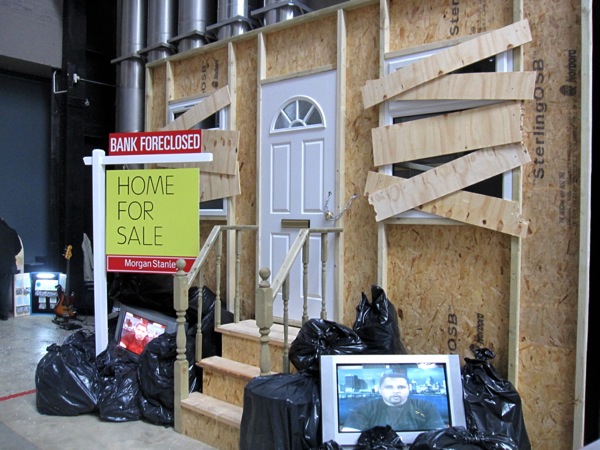
"Tate Modern: Tomorrow Is Another Day (After the Economic Crisis)" installation produced by Not An Alternative for the Tate Modern’s 10th anniversary show “No Soul for Sale: A Festival of Independents.” The work implicated corporate sponsor, Morgan Stanley, for its role in the economic crisis. The piece was accompanied by an essay situating the work art historically as in intervention on participatory art, while simultaneously linking it to other local campaigns targeting Tate sponsorship. May 14-16, 2010 Photo by Not An Alternative.
I encountered the art group Not An Alternative for the first time about a month ago in Corona, Queens, where Tania Bruguera (featured last month in 5 Questions) had assembled a panel on “useful art.” What immediately impressed me was the group’s ability to articulate its ongoing project, which aims both to create new spaces for cultural production and to question the ways that various participatory structures (social media, election processes, relational aesthetics) exclude certain subjects and amplify social and economic inequalities by means of participation.
Through their highly engaged work, work that functions somewhere between political activism, social service, and institutional critique, Not An Alternative confront the limits of what political theorist Jodi Dean has called, after a variety of critical theoretical debates, “communicative capitalism.” In a time of communicative capitalism, our political and social participation is increasingly exploited by the use of new media. Not An Alternative foregrounds this fact, presenting ways of navigating a relatively new digital landscape in which values once cherished by the militant left and avant-garde alike–participation, reflexivity, interactivity–have become corporate watchwords for how neoliberalism manages consent in a networked age.
Networked for some, but obviously not for all. Not An Alternative’s work is also crucial in the ways that it foregrounds exclusion, offering ways to visualize the limits of participation in a society in which obviously one’s ability to participate is largely determined by social and economic privilege. As Not An Alternative said during their presentation in Corona, referring to their collaboration with a homeless advocacy group in the Bronx (discussed below), they recognize the important of “desubjectifying” themselves, where to draw attention to their efforts may work against the causes of the community groups with whom they choose to work.
The Not (or nots, plural) of Not An Alternative are significant in a time in which terms like “collaboration,” “participation,” and “interactivity” remain largely unquestioned. What would it mean to drop out, when dropping out would no longer seem an option? Not An Alternative do not so much drop out as use the resources and machinery of communicative capitalism to produce a different set of results that undermine the seamless functioning of neoliberalism. In this way they negate and refuse, but their refusal also has a positive effect.
One such project that has been able to throw a wrench in the flow of communicative capitalism is Not An Alternative’s collaboration with Greenpeace against the Kleenex corporation’s 2007 PR campaign in Times Square, “Let in Out.” Infiltrating the campaign — in which the corporation asked passersby to rehearse meaningful events from their life — at the crucial moment when they were expected to shed tears, they would reveal to Kleenex’s cameras and cameras planted by Not An Alternative/Greenpeace that what truly moved them was the fact that the corporation was still using virgin forests to produce their tissues. When Not An Alternative’s counter-campaign went viral, Kleenex was effectively halted in its efforts to exploit the tears of participants for commercial profit.
Pushing against the structural limitations of new media and of existing institutional dynamics, Not An Alternative extend the work of other artists and activists who have successfully intervened in corporate, liberal democracy through symbolic action — actions which use a terrain of symbols and images against their intended use. They do this while also modeling modes of participation and interactivity that can better organize against neoliberalism, and by creating spaces in which new modes of collective agency can emerge, such as their No↔Space storefront in Williamburg, Brooklyn, where the group gathers for meetings and hosts events for their community.
1. What inspired you to start Not An Alternative?
Not An Alternative formed in the lead-up to the Republican National Convention in NY, a very politically charged time. As a group of people, we came from diverse backgrounds, each interested in a cross-disciplinary approach to our work. The activists wanted to integrate culture and aesthetics into politics in impactful ways. The artists sought to extend their practice beyond the institution of art. The PR flacks wanted to use their skills to do something other than sell products.
It was an exciting moment, but everyone’s energy went to getting Bush out of office, with an expectation that real change was around the corner. We felt that popular forms of political engagement were too narrowly focused on pragmatic ends at the expense of any truly systemic challenge. Not only that, we felt that in many cases our issue-focused campaigns actually fortified a system we would otherwise wish to oppose.
Capitalism is constructed to instrumentalize any form of engagement. How can we refuse this? Can we participate productively within a context where it’s either vote, engage, participate, or you’re apathetic. Can we vote no? We were inspired to create an organization that experimented with a form of engagement that was aimed at confronting the limits of liberal capitalism.
Our name is derived from a famous Margaret Thatcher quote. Her statement “there is no alternative,” originally made in the 1980s, has become emblematic of the idea that there is no exterior to the capitalist system. For years, Thatcher’s statement served as the quote most used to characterize an era in which it is very difficult to imagine any real alternative to the system she described.
In the case of the name Not An Alternative, we promote a misreading of Thatcher’s words that functions as an inversion of their original intention. It represents, where “there is no alternative,” something that actually is no-alternative. With a slight twist, we shift from something in the negative to nothing in the positive.
This shift demonstrates a rupture, an internal antagonism. Our struggles are not between and amongst, but rather within, and against. A real alternative is not exterior, it can be found in the subject itself. Not An Alternative has a mission to produce this shift. Our projects, as demonstrated in the example of Thatcher’s quote, are aimed at finding those impossible instances in a given system (its inherent limit) and making them visible.
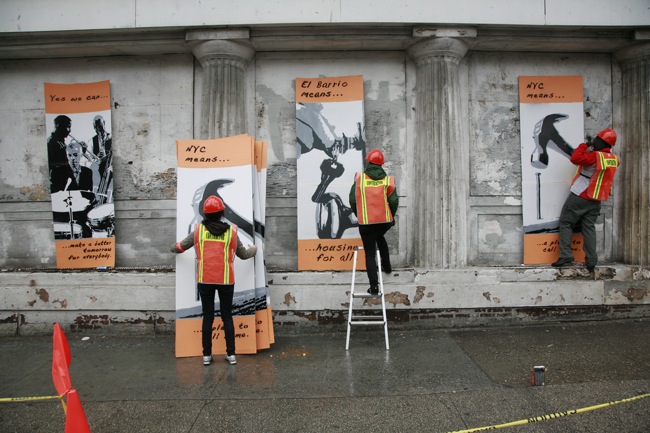
Not An Alternative and allies working in collaboration with Picture the Homeless on a building occupation in East Harlem, El Barrio. Part of a campaign to bring attention the contradiction and failure in Mayor Bloomberg's five-year plan to end homelessness by making visible the thousands of city and bank owned properties sitting vacant in New City. March 19, 2009. Photo by Andrew Stern.
2. Why do you feel there a need for organizations like Not An Alternative, which produce aesthetic objects and actions that intend a direct effect upon their social contexts and the communities with whom they choose to work (if that’s how you’d describe what Not An Alternative does)?
We wouldn’t describe our practice that way. We would tend not to use the term “produce” to describe our relationship to aesthetic objects. “Remake” might be a better word, as it has never been our intention to introduce new, different, or alternative aesthetics to any situation. Instead, through acts designed to remake what already exists, we aim to transform understandings of what people hold to be true.
We exist currently within a crisis of representation. We come up with new forms and they are integrated directly as fuel for a system that is fundamentally unsustainable. Our solutions are sucked into the brand identities of institutions. As Not An Alternative, we are not interested in the production of solutions or the inclusion of new subjectivities or symbols, but rather the excavation and occupation of existing ones, revealing an inherent split.
We understand any given thing to be constituted both by its positive attributes and by what it is not, what it refuses or excludes. This omission, or invisible factor, is what we seek to reveal.
Our work takes the form of installations and/or interventions within arts institutions and in public space, and often in collaboration with community groups. With the understanding as we’re entering into these collaborations that our aims are not necessarily the same as the community group’s aims. We aren’t aiming for a specific reform or legislative “win.” We are interested in exposing exclusions, pointing out the limits of a given system, and in doing so, producing shifts or transformations of the system or subjectivity itself.

"Foreclosed Building Façade" produced by Not An Alternative for bank bailout demonstration on Wall St. NYC. Organized by AFL-CIO, SEIU, National People's Action. April 30, 2010 Photo by New York Post.
3. Are there other projects, people, and/or things that have inspired Not An Alternative (past or present)? Please describe.
We draw inspiration from a wide range of sources including but not limited to the realms of art, activism, and theory.
In art we’re interested in what we’d call “un-nominated art,” art that isn’t declared as such, or its designation is even actively disavowed. Duchamp’s urinal, prior to being nominated, would be an example. Once designated, his urinal is elevated above all other urinals, as precious or distinct. We see value in the active refusal of this kind of designation.
In the same vein, we are interested in the anonymous art/activism blocs that appear in one form or another as a part of mass mobilizations: the Book Bloc, Tute Bianche, and Black Bloc. They eschew individualism, refusing to acknowledge their work as a personal artistic expression. These actions aim instead to produce collective symbols of global resistance.
Another art tradition from which we take inspiration is the genre known as “institutional critique,” as represented in the works of Hans Haacke, Jenny Holzer, Mark Dion, Fred Wilson, Andrea Fraser, and Alfredo Jaar. The interventions of these artists use the visual iconography and language of the host institution against itself to reveal a gap, an internal contradiction. However, there are limitations to this practice. The “critical perspective” from which the artist/author speaks constructs a vantage point that is separate from the institution, that is “outside” it, as it were. The artist speaks for herself and the institution can happily sponsor the work without endorsing its position.
But what happens when you speak on behalf of the institution and dissolve the separation? We are interested in forms of identification that are both critical and wholly embedded, negating the removed vantage of an exterior author. In this way, the institution is obliged to take a position.
From the realm of theory we’re inspired by Slavoj Zizek for his determination to fight for radical understandings of causes that most everyone else would consider “lost.” We’re big fans of Bronx-based Picture the Homeless, a homeless-led organization, for taking on what they call the “shelter industrial complex.” They don’t aim for temporary solutions, they demand systemic change. In this way, we see them as a model for what we wish more groups could be.
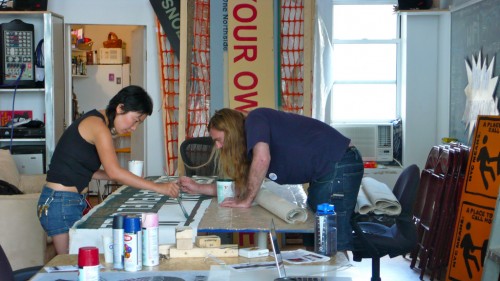
Props Production at No↔Space. Not An Alternative’s work involves both questioning the tools of advertising, marketing, public relations, and spectacle production and also leveraging them to affect popular understandings of events, symbols and history. July 15, 2009. Photo by Alana Star.
4. What have been your favorite projects to work on and why?
A recurring theme of our work is what we’d call “participationism.” With participation now a dominant paradigm, structuring social media, art, activism, the architecture of the city, and the economy, we are all integrated into participatory structures whether we want to be or not. We take the position that in order to build a practice that enables political, social, and economic transformation, one must engage power in a way that is specific to its contemporary form.
Too often, it seems, progressives believe that power operates exclusively from above, that command and control emanate from some centralized, closed authority. It is no wonder that many latch on to notions of openness, transparency, and participation as radical ends in themselves, but we must not fetishize process over product. Participatory frameworks are not in and of themselves politically significant, nor is power limited to distant and impersonal structures. We believe that power is diffuse and distributed, operating through us and on us; participation can therefore turn into a vector for dominant ideologies as easily as it can liberate.
Our favorite projects aim to confront the limits of participation or participatory structures, and the way liberal capitalism, which is oriented around a logic of participation, functions to subsume, commodify, and co-opt.
In one project, we were uninvited participants in an urban development ad campaign co-sponsored by the city with real estate developers in El Barrio. Our contribution involved the re-contextualization of their ad campaign aesthetics and promotional slogans (“New York City Means A Place to Call Home”) onto the façade of a vacant building owned by the city during a building occupation action by members of the Bronx-based community group, Picture the Homeless.
The homeless population continues to escalate at the same time that landlords and the city sit on empty buildings. In fact, the total volume of potential apartments in vacant buildings and lots in Manhattan alone exceeds the number of homeless households in shelters and on the street citywide. We sought to reveal the contradiction between the city’s promises and their practice.
In the case of our curatorial work, last year we worked with Eyebeam to co-produce a show called Re:Group: Beyond Models of Consensus. In it, we presented the work of artists like John Hawke, the Institute for Infinitely Small Things, The Yes Men, Christopher Robbins, and others. Their projects modeled participatory forms of critical engagement that function to foreground the contours and boundaries of participation, reinterpreting the institutional structures they’re participating in as having an inherent antagonism. Visitors were invited to participate in training workshops that open-sourced the artists’ practice, resulting in new participatory interventions.
5. What projects do you see in the future for Not An Alternative? What direction would you like to take the organization in?
Our projects explore the relationship between immaterial and material, the city as a stage. Recently we’ve been moving in the direction of working more explicitly with urbanism and spatial politics. And we’re in good company: increasingly, artists and activists, designers and urban farmers are exploring ideas for the sustainable city. But our fixed gear bikes and rooftop farms, geo-location apps, and LEED certified lofts are lifestyles-cum-commodities, quickly subsumed into city brand campaigns, used to sell a spatial agenda. Kill your Facebook profile, grow your food; you are still a walking talking advertisement for gentrification whether you like it or not.
Everything, including the representation of our own bodies, has become factored into the neoliberal economy. Neoliberalism functions according to a logic that aims at neutralizing conflict by turning expressions of difference into currency that fortifies the system. But we understand the immaterial social and symbolic space, i.e. the world of representation, to be contested terrain. In this environment, subtle alterations of the symbolic geography can radically affect the physical landscape.
Given these conditions, we’re interested in projects that create the coordinates for looking at the space around us in a way that defamiliarizes us from what we see or think we know. It’s an act of remapping. Rather than creating new (commodifiable) forms we see potential in existing forms. In intervening upon symbols that structure or govern our use of space, we have a certain amount of power to re-order the world.
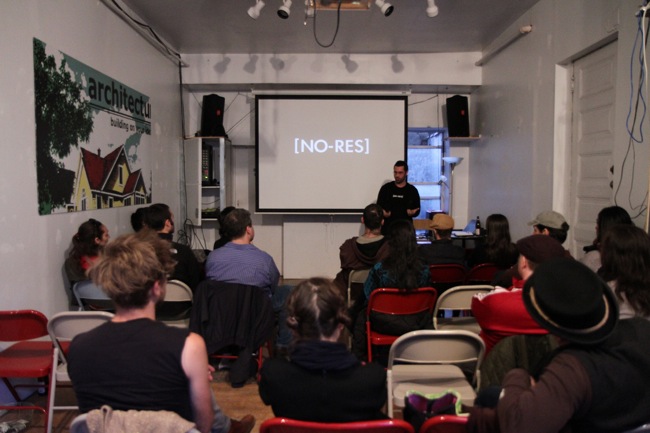
Event at No↔Space No-Space is host to free lectures, screenings, panel discussions, workshops, and artist presentations. The space also consists of a production workshop, filming studio, and video editing suite. During the day, it is a collaborative office space (aka coworking) for freelancers and cultural producers. May 5, 2011 Photo by Not An Alternative.

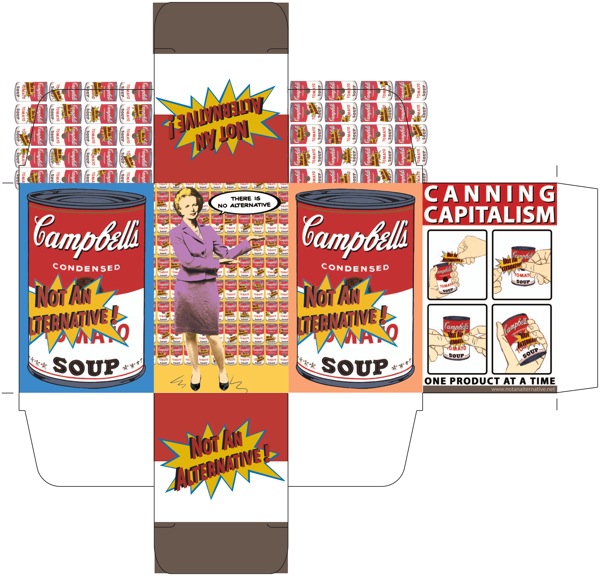



Pingback: Art on the streets « A Travesty of Art Blogging